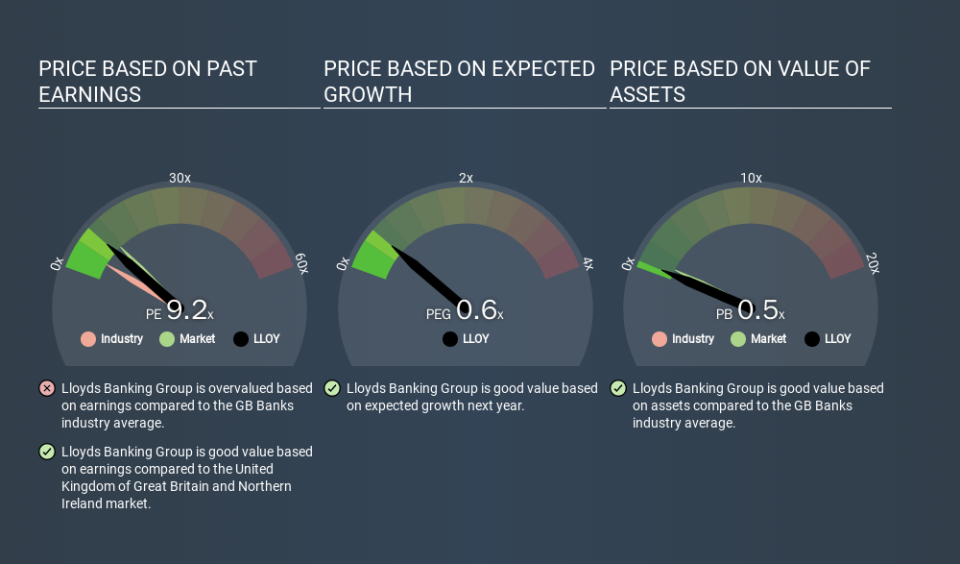A Sliding Share Price Has Us Looking At Lloyds Banking Group plc's (LON:LLOY) P/E Ratio

Unfortunately for some shareholders, the Lloyds Banking Group (LON:LLOY) share price has dived 42% in the last thirty days. That drop has capped off a tough year for shareholders, with the share price down 48% in that time.
Assuming nothing else has changed, a lower share price makes a stock more attractive to potential buyers. While the market sentiment towards a stock is very changeable, in the long run, the share price will tend to move in the same direction as earnings per share. The implication here is that long term investors have an opportunity when expectations of a company are too low. Perhaps the simplest way to get a read on investors' expectations of a business is to look at its Price to Earnings Ratio (PE Ratio). Investors have optimistic expectations of companies with higher P/E ratios, compared to companies with lower P/E ratios.
Check out our latest analysis for Lloyds Banking Group
How Does Lloyds Banking Group's P/E Ratio Compare To Its Peers?
Lloyds Banking Group's P/E of 9.22 indicates some degree of optimism towards the stock. As you can see below, Lloyds Banking Group has a higher P/E than the average company (4.6) in the banks industry.
Lloyds Banking Group's P/E tells us that market participants think the company will perform better than its industry peers, going forward. Shareholders are clearly optimistic, but the future is always uncertain. So investors should delve deeper. I like to check if company insiders have been buying or selling.
How Growth Rates Impact P/E Ratios
Generally speaking the rate of earnings growth has a profound impact on a company's P/E multiple. If earnings are growing quickly, then the 'E' in the equation will increase faster than it would otherwise. And in that case, the P/E ratio itself will drop rather quickly. Then, a lower P/E should attract more buyers, pushing the share price up.
Lloyds Banking Group's earnings per share fell by 37% in the last twelve months. But it has grown its earnings per share by 16% per year over the last five years.
Remember: P/E Ratios Don't Consider The Balance Sheet
The 'Price' in P/E reflects the market capitalization of the company. So it won't reflect the advantage of cash, or disadvantage of debt. The exact same company would hypothetically deserve a higher P/E ratio if it had a strong balance sheet, than if it had a weak one with lots of debt, because a cashed up company can spend on growth.
Such spending might be good or bad, overall, but the key point here is that you need to look at debt to understand the P/E ratio in context.
Is Debt Impacting Lloyds Banking Group's P/E?
Lloyds Banking Group has net debt worth 25% of its market capitalization. That's enough debt to impact the P/E ratio a little; so keep it in mind if you're comparing it to companies without debt.
The Bottom Line On Lloyds Banking Group's P/E Ratio
Lloyds Banking Group's P/E is 9.2 which is below average (11.8) in the GB market. The debt levels are not a major concern, but the lack of EPS growth is likely weighing on sentiment. What can be absolutely certain is that the market has become more pessimistic about Lloyds Banking Group over the last month, with the P/E ratio falling from 16.0 back then to 9.2 today. For those who prefer to invest with the flow of momentum, that might be a bad sign, but for deep value investors this stock might justify some research.
Investors have an opportunity when market expectations about a stock are wrong. If it is underestimating a company, investors can make money by buying and holding the shares until the market corrects itself. So this free visualization of the analyst consensus on future earnings could help you make the right decision about whether to buy, sell, or hold.
But note: Lloyds Banking Group may not be the best stock to buy. So take a peek at this free list of interesting companies with strong recent earnings growth (and a P/E ratio below 20).
If you spot an error that warrants correction, please contact the editor at editorial-team@simplywallst.com. This article by Simply Wall St is general in nature. It does not constitute a recommendation to buy or sell any stock, and does not take account of your objectives, or your financial situation. Simply Wall St has no position in the stocks mentioned.
We aim to bring you long-term focused research analysis driven by fundamental data. Note that our analysis may not factor in the latest price-sensitive company announcements or qualitative material. Thank you for reading.

 Yahoo Finance
Yahoo Finance 
